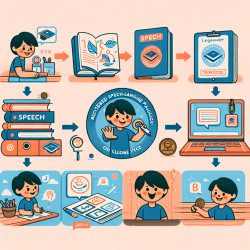Introduction
The development of neural responses in infants, particularly those at high risk for Autism Spectrum Disorder (ASD), is a crucial area of research. A recent study titled Development of neural responses to hearing their own name in infants at low and high risk for autism spectrum disorder provides insights into how infants process their own names, a critical social cue. This research offers valuable implications for practitioners working with infants, especially those at risk for ASD.
Research Overview
The study examined event-related potentials (ERPs) in infants at 10 and 14 months old, both at low and high risk for ASD. The researchers hypothesized that low-risk infants would show enhanced frontal ERP responses to their own names compared to unfamiliar names. In contrast, high-risk infants were expected to show attenuated or absent differences in ERP responses.
Interestingly, the study found that while low-risk infants did not exhibit the expected enhanced ERP responses to their own names, high-risk infants showed attenuated frontal positive-going activity to their own names compared to unfamiliar names at 14 months. This suggests that infants at high risk for ASD begin to process their own names differently shortly after one year of age, coinciding with rapid frontal brain development.
Implications for Practitioners
For practitioners, these findings highlight the importance of early detection and intervention in infants at high risk for ASD. Here are some ways practitioners can apply these insights:
- Early Screening: Implement early screening tools that focus on neural responses to social cues like the infant's own name. This can help identify atypical neural processing early on.
- Tailored Interventions: Develop interventions that enhance social cue processing in high-risk infants. This could involve auditory training or interactive activities that emphasize name recognition.
- Parental Involvement: Encourage parents to engage in activities that involve calling the infant's name in various contexts, enhancing familiarity and social engagement.
- Further Research: Encourage further research into neural responses in infants, focusing on different social cues and their impact on early development.
Encouraging Further Research
While this study provides valuable insights, it also opens avenues for further research. Practitioners and researchers should consider exploring the following areas:
- Longitudinal Studies: Conduct longitudinal studies to track neural response development over time and its correlation with ASD diagnosis.
- Broader Social Cues: Investigate how infants respond to other social cues, such as facial expressions or gestures, and their neural correlates.
- Intervention Efficacy: Study the efficacy of different intervention strategies on enhancing neural responses to social cues in high-risk infants.
Conclusion
The study on neural responses to hearing their own name in infants at low and high risk for ASD offers significant insights into early neural processing differences. Practitioners can leverage these findings to enhance early detection and intervention strategies, ultimately supporting better developmental outcomes for high-risk infants.
To read the original research paper, please follow this link: Development of neural responses to hearing their own name in infants at low and high risk for autism spectrum disorder.










